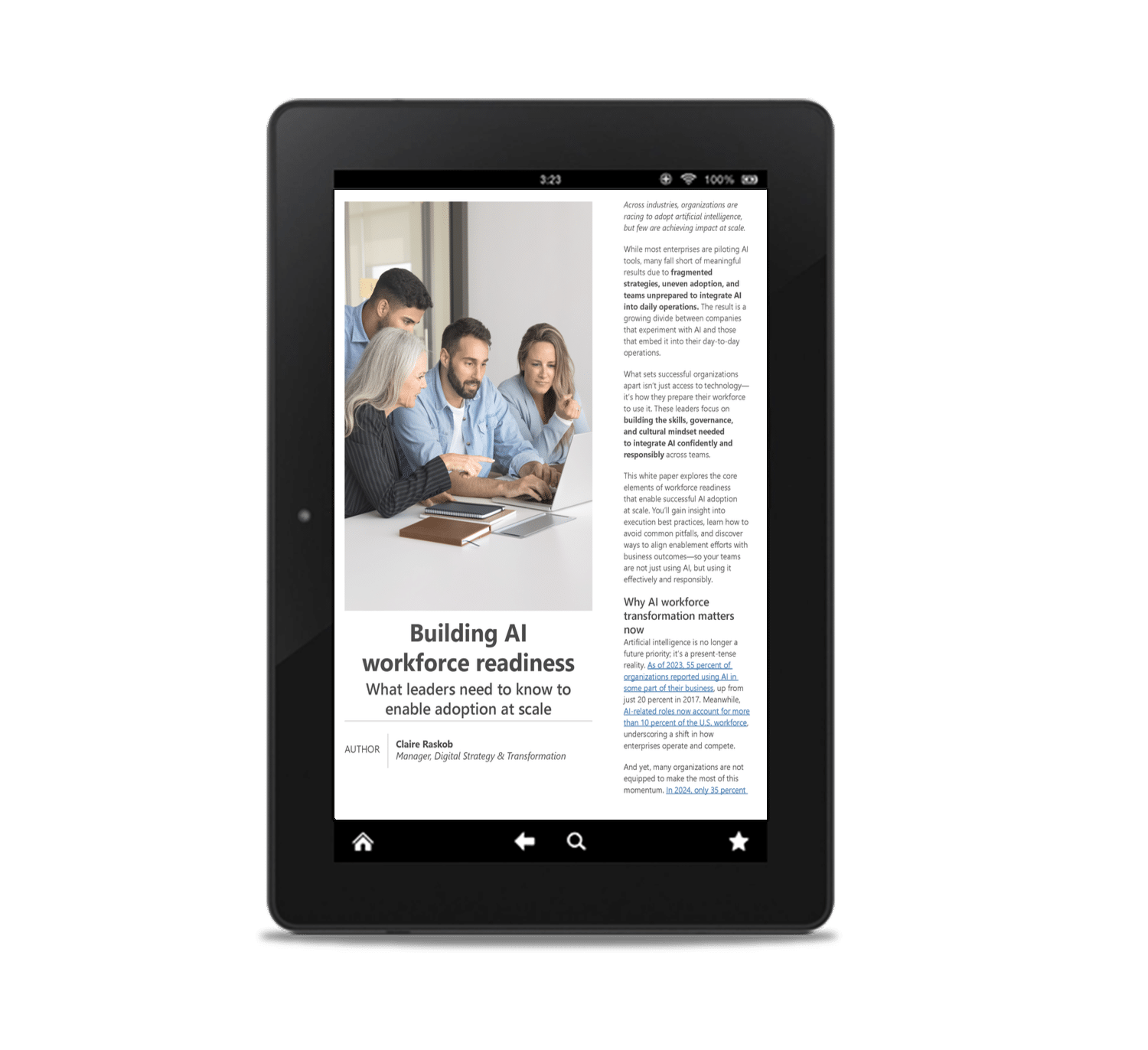Practical insights to prepare your teams—and your organization—for responsible AI adoption at scale
AI is transforming how work gets done, and the most successful organizations aren’t just adopting new tools. They’re preparing their people to use them confidently, effectively, and responsibly.
Yet many enterprises stall after early pilots, held back by skill gaps, cultural resistance, or unclear governance. Our experts explore what separates high-performing programs from the rest and offer a practical lens on how to move from experimentation to enterprise-wide impact.
Download the white paper to explore how leading organizations are bridging the gap between AI ambition and workforce readiness.
Key takeaways
How skill gaps, cultural friction, and lack of governance can stall enterprise AI adoption
What high-performing programs do differently
The execution practices that separate scalable AI initiatives from stalled pilots
How to measure impact
Which metrics best reflect adoption, value creation, and alignment with business outcomes
Where to start
A structured approach to assessing AI readiness across strategy, people, data, technology, and governance
Grab your copy of Building AI workforce readiness: What leaders need to know to enable adoption at scale:

A glimpse into Building AI workforce readiness: What leaders need to know to enable adoption at scale
The three building blocks of AI workforce readiness
Successful AI adoption isn’t just a matter of rolling out new tools. It requires a thoughtful enablement approach that prepares teams to use AI confidently, consistently, and with purpose. This readiness hinges on three foundational elements:
1. Enablement strategy and tools: Aligning teams, roles, and goals
Workforce enablement begins with a strategy that links AI capabilities to real business needs. Businesses must define the specific roles AI will play within the organization, whether that involves streamlining internal operations, supporting customer-facing teams, or enhancing decision-making. Mapping enablement efforts to functional goals across departments like finance, HR, legal, and engineering is equally important.
Supporting the strategy are practical tools and frameworks, including playbooks, role-specific adoption resources, and change management plans that account for differences in team readiness and maturity. When well executed, enablement strategy bridges the gap between corporate vision and day-to-day implementation.
2. AI literacy and fluency: Building confidence through persona-based learning paths
AI tools are only as effective as the people using them. Building AI literacy, starting with foundational knowledge and evolving toward role-specific fluency, is critical to long-term success. The goal is not to turn every employee into a data scientist. It’s to help teams understand what AI can do, when to trust it, and how to apply it in the unique context of their day-to-day operations.
Persona-based learning paths are one of the most effective ways to build this confidence. Tailored to specific functions, these paths introduce practical AI concepts through real use cases and familiar workflows. By focusing on relevance over theory, they empower employees to engage with AI more naturally in their daily work.
3. Governance and measurement: Ensuring scale and sustainability
Governance is the backbone of enterprise AI adoption. It ensures that the organization can move quickly without compromising security, compliance, or trust. Scalable governance includes clear policies on data use, access controls, and responsible AI practices, as well as oversight structures like an AI Center of Excellence.
Equally important is the ability to measure impact. Without clear metrics, it’s difficult to track progress or justify investment. Governance frameworks should include performance measurement at both the individual and organizational level, covering metrics ranging from tool adoption to productivity gains and risk mitigation. When governance and measurement are embedded from the outset, they enable AI initiatives to scale responsibly and deliver sustained value.Ready for more?

